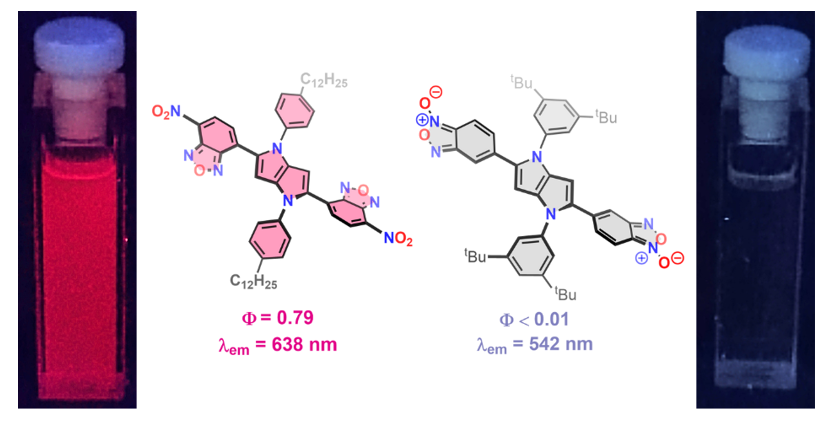Article in Chemical Science (2024)
28 12 2024
A paper, co-authored by PhD students Bartosz Szymański and Piotr Łaski together with Radosław Kamiński and Katarzyna N. Jarzembska, was published in the Chemical Science journal (Royal Society of Chemistry). The investigations published in the article entitled “Shedding new light on quadrupolar 1,4-dihydropyrrolo[3,2-b]pyrroles: impact of electron-deficient scaffolds over emission” were conducted within the collaboration with the Daniel T. Gryko team from the Institute of Organic Chemistry of the Polish Academy of Sciences.
Quadrupolar dyes exhibit exceptional optical properties, which make them one of the most intensively studied and developed groups of functional materials. Particular interest is focused on their potential to shift the emission spectrum into the deep-red or near-infrared range. Such systems can find applications in optoelectronics, cell labelling, and fluorescence-guided surgery. Designing dyes with specific photophysical properties requires comprehensive theoretical, structural, and optical studies to understand how individual molecular fragments influence on the properties of the dye in solution and in the solid state.
Through collaboration with organic chemists from the Institute of Organic Chemistry of the Polish Academy of Sciences and theoreticians from Linköping University and the University of Helsinki, quadrupolar dyes from the pyrrolo[3,2-b]pyrroles group connected with strongly electron-withdrawing heterocycles were studied for the first time. This molecular architecture enabled record among centrosymmetric quadrupolar dyes bathochromic shifts of the absorption and emission maxima within the deep-red range, while maintaining high fluorescence quantum yields. Moreover, the obtained dyes exhibit significant emission yields even in the solid state. Detailed structural analysis revealed that intramolecular interactions in the solid state have a substantial impact on the position of the absorption maximum and the fluorescence quantum yield. Additionally, theoretical studies clarified the observed differences in optical properties, highlighting the role of the charge transfer and internal conversion as dominant deactivation pathways.
Presented results provide valuable insights into the design of new quadrupolar dyes with desired properties and enable the prediction of photophysical characteristics in the solid state based on knowledge of their structure and optical properties in solution.
The research was carried out, among others, as part of the National Science Centre projects OPUS 2020/37/B/ST4/00017, HARMONIA 2018/30/M/ST5/00460).
Bibliographic data and link to the article:
B. Szymański, S.R. Sahoo, O. Vakuliuk, R. Valliev, R. Ramazanov, P. Łaski, K.N. Jarzembska, R. Kamiński, M.B. Teimouri, G. Baryshnikov, D.T. Gryko, Chemical Science 2024, DOI: 10.1039/d4sc07275h
https://doi.org/10.1039/d4sc07275h

